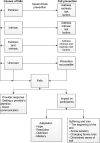The beginning of the end: A qualitative study of falls among HIV+ individuals
- PMID: 30408088
- PMCID: PMC6224109
- DOI: 10.1371/journal.pone.0207006
The beginning of the end: A qualitative study of falls among HIV+ individuals
Erratum in
-
Correction: The beginning of the end: A qualitative study of falls among HIV+ individuals.PLoS One. 2019 Apr 24;14(4):e0216192. doi: 10.1371/journal.pone.0216192. eCollection 2019. PLoS One. 2019. PMID: 31017973 Free PMC article.
Abstract
Falls are an important concern for individuals living with HIV (HIV+). The purpose of this study was to understand perceptions of HIV+ individuals who had fallen regarding what caused their falls, prevention strategies that they used, and the impact of falls on their lives. Qualitative Description was the approach best suited to our study. We conducted in-depth interviews with 21 HIV+ individuals aged 47 to 71 years who had fallen within the past two years and who received care in a primary care/HIV clinic. Participants identified causes of falls as intrinsic (HIV, opportunistic infections, antiretroviral therapy, substance use, polypharmacy) or extrinsic (icy sidewalks, wet floors). Among those who felt that their falls could be prevented, prevention strategies included physical therapy and avoiding extrinsic fall risk factors. Some participants, however, felt that their falls could not be prevented. While some participants responded adaptively to falls, for many, the experience of falling was connected with deep feelings of loss and suffering. For these individuals, falls were understood to be "the beginning of the end" and a source of social isolation, changing family roles, diminished sense of self, and stigma.
Conflict of interest statement
The authors have declared that no competing interests exist.
Figures
Similar articles
-
Factors that influence the risk of falling after spinal cord injury: a qualitative photo-elicitation study with individuals that use a wheelchair as their primary means of mobility.BMJ Open. 2020 Feb 25;10(2):e034279. doi: 10.1136/bmjopen-2019-034279. BMJ Open. 2020. PMID: 32102820 Free PMC article.
-
Barriers faced by healthcare professionals when managing falls in older people in Kuala Lumpur, Malaysia: a qualitative study.BMJ Open. 2015 Nov 5;5(11):e008460. doi: 10.1136/bmjopen-2015-008460. BMJ Open. 2015. PMID: 26546140 Free PMC article.
-
Views and experiences of Malaysian older persons about falls and their prevention-A qualitative study.BMC Geriatr. 2016 May 6;16:97. doi: 10.1186/s12877-016-0274-6. BMC Geriatr. 2016. PMID: 27153989 Free PMC article.
-
Developing a falls prevention program for community-dwelling stroke survivors in Singapore: client and caregiver perspectives.Disabil Rehabil. 2019 May;41(9):1044-1054. doi: 10.1080/09638288.2017.1419293. Epub 2017 Dec 25. Disabil Rehabil. 2019. PMID: 29277114
-
Older people's experiences of falling and perceived risk of falls in the community: A narrative synthesis of qualitative research.Int J Older People Nurs. 2017 Dec;12(4). doi: 10.1111/opn.12151. Epub 2017 May 22. Int J Older People Nurs. 2017. PMID: 28544356 Review.
Cited by
-
Alcohol Use and Its Associations With Frailty, Fractures, and Falls Among Older Adults With HIV.Alcohol Res. 2025 Aug 8;45(1):08. doi: 10.35946/arcr.v45.1.08. eCollection 2025. Alcohol Res. 2025. PMID: 40792193 Free PMC article. Review.
-
Outdoor Environmental Risk Factors for Falls and Fear of Falling: A Systematic Review.Gerontologist. 2025 Apr 9;65(5):gnaf078. doi: 10.1093/geront/gnaf078. Gerontologist. 2025. PMID: 39969174
-
Alcohol Consumption and Illicit Drug Use: Associations With Fall, Fracture, and Acute Health Care Utilization Among People With HIV Infection.J Acquir Immune Defic Syndr. 2024 Apr 1;95(4):391-398. doi: 10.1097/QAI.0000000000003372. J Acquir Immune Defic Syndr. 2024. PMID: 38133581 Free PMC article.
-
Alcohol and falls among people with HIV infection: A view from Russia and the United States.Alcohol Clin Exp Res. 2022 Sep;46(9):1742-1752. doi: 10.1111/acer.14915. Epub 2022 Aug 11. Alcohol Clin Exp Res. 2022. PMID: 35957545 Free PMC article.
-
Correction: The beginning of the end: A qualitative study of falls among HIV+ individuals.PLoS One. 2019 Apr 24;14(4):e0216192. doi: 10.1371/journal.pone.0216192. eCollection 2019. PLoS One. 2019. PMID: 31017973 Free PMC article.
References
-
- American Geriatrics Society British Geriatrics Society, and American Academy of Orthopaedic Surgeons Panel on Falls Prevention. Guideline for the prevention of falls in older persons. Journal of the American Geriatrics Society. 2001;49(5):664–72. - PubMed
-
- Fletcher PC, Hirdes JP. Risk factors for falling among community-based seniors using home care services. The journals of gerontology. 2002;57(8):M504–10. - PubMed
-
- Leipzig RM, Cumming RG, Tinetti ME. Drugs and falls in older people: a systematic review and meta-analysis: II. Cardiac and analgesic drugs. Journal of the American Geriatrics Society. 1999;47(1):40–50. - PubMed
Publication types
MeSH terms
Grants and funding
LinkOut - more resources
Full Text Sources
Medical
Miscellaneous


